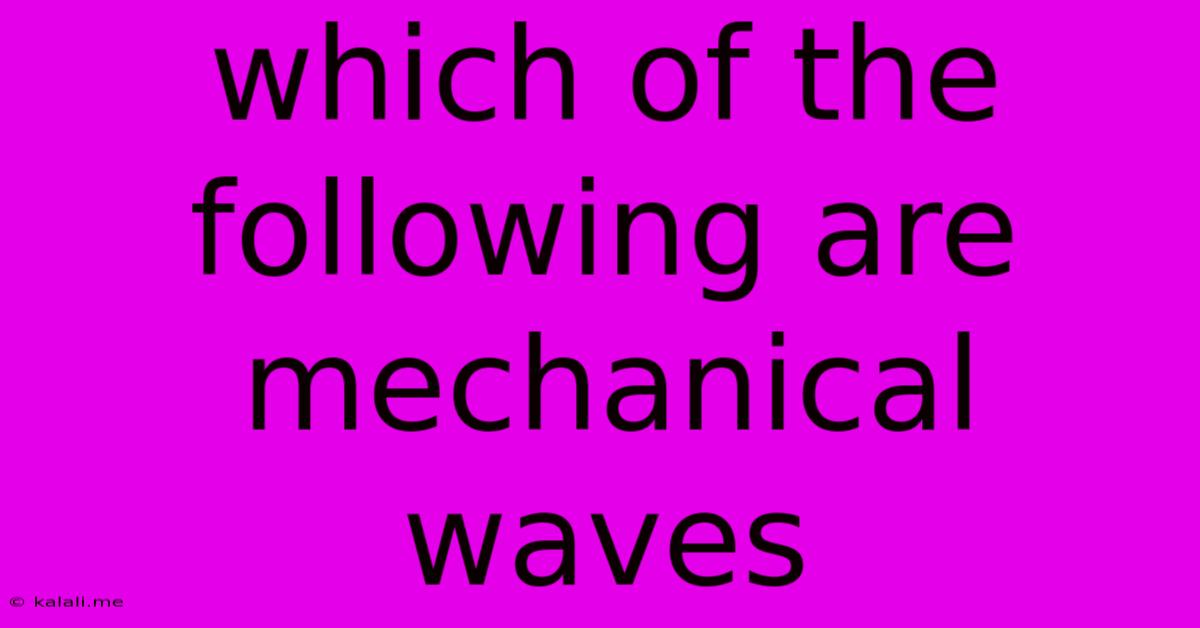Which Of The Following Are Mechanical Waves
Kalali
Jun 14, 2025 · 3 min read

Table of Contents
Which of the Following Are Mechanical Waves? Understanding Wave Types
This article will explore the fascinating world of waves, specifically focusing on mechanical waves. We'll define what constitutes a mechanical wave and then analyze different wave types to determine their classification. Understanding this distinction is crucial in various fields, from physics and engineering to seismology and oceanography. By the end, you'll be able to confidently identify mechanical waves from a given list.
What are Mechanical Waves?
A mechanical wave is a disturbance that travels through a medium by transferring energy from one particle to another. Unlike electromagnetic waves, which can travel through a vacuum, mechanical waves require a medium such as air, water, solids, or even a combination of these. Think of dropping a pebble into a pond – the ripple effect is a mechanical wave traveling through the water. The key is the interaction and transfer of energy between the particles of the medium.
Key Characteristics of Mechanical Waves:
- Require a Medium: This is the defining characteristic. Without a medium, there's no way for the wave to propagate.
- Energy Transfer: The wave transfers energy, not matter. The particles in the medium oscillate around their equilibrium position, transferring energy along the wave's path.
- Types: Mechanical waves come in two main types:
- Transverse Waves: The particles of the medium vibrate perpendicular to the direction of wave propagation. Think of a wave on a string – the string moves up and down, while the wave travels horizontally. Examples include light waves (although they are electromagnetic and don't need a medium for propagation in a vacuum) and seismic S-waves.
- Longitudinal Waves: The particles of the medium vibrate parallel to the direction of wave propagation. Sound waves are a classic example. The air molecules compress and expand along the direction the sound is traveling. Seismic P-waves are also longitudinal.
Identifying Mechanical Waves: A Practical Approach
To determine whether a wave is mechanical, ask yourself: Does it require a medium to travel? If the answer is yes, it's a mechanical wave. If it can travel through a vacuum, it's likely an electromagnetic wave (like light or radio waves).
Let's consider some examples:
- Sound Waves: These are mechanical waves because they require a medium (air, water, solids) to travel.
- Water Waves: These are mechanical waves traveling through water.
- Seismic Waves (P-waves and S-waves): Both P-waves (longitudinal) and S-waves (transverse) are mechanical waves traveling through the Earth.
- Light Waves: These are electromagnetic waves, not mechanical waves. They can travel through a vacuum.
- Radio Waves: Like light waves, these are electromagnetic waves and do not require a medium.
Conclusion:
Identifying mechanical waves hinges on understanding their fundamental requirement: a medium for propagation. By asking whether a wave needs a medium to travel, you can effectively classify it. This understanding is critical in numerous scientific and engineering disciplines, providing a foundational understanding of wave phenomena in our world. Remember the key characteristics – the need for a medium, energy transfer, and the distinction between transverse and longitudinal waves – and you'll be well-equipped to tackle any wave identification challenge.
Latest Posts
Latest Posts
-
Respiratory System Questions And Answers Pdf
Jun 15, 2025
-
Which Of The Following Are Two Classes Of Resistors
Jun 15, 2025
-
A Student Has Successfully Passed 60 Percent
Jun 15, 2025
-
Least Common Multiple Of 6 15 And 9
Jun 15, 2025
-
Difference Between An Estuary And A Delta
Jun 15, 2025
Related Post
Thank you for visiting our website which covers about Which Of The Following Are Mechanical Waves . We hope the information provided has been useful to you. Feel free to contact us if you have any questions or need further assistance. See you next time and don't miss to bookmark.